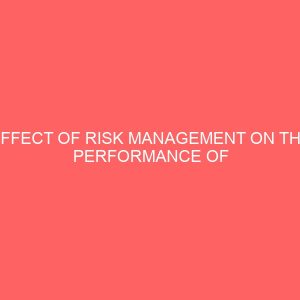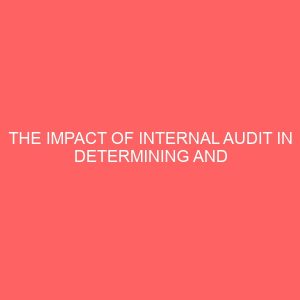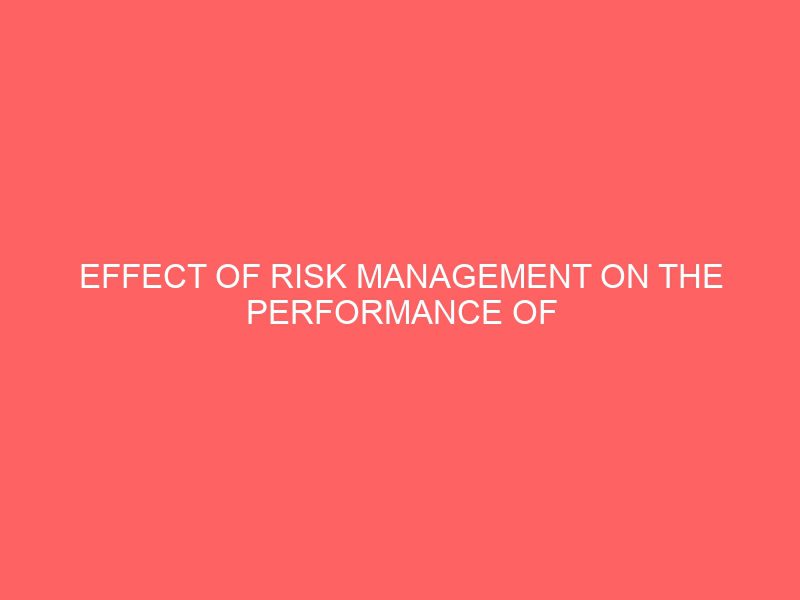Description
CHAPTER ONE
INTRODUCTION
1.1 BACKGROUND OF THE STUDY
Modern banking began in Nigeria in 1982 when the African Banking Corporation (ABC) based in South Africa opened a branch in Lagos. ABC was taken over by British Bank for West Africa (BBWA) and subsequently changed its name to Standard Bank in 1894 and then to First Bank of Nigeria in 1894. According to Nwankwo (1991), other early comers included the Anglo-African Bank established in 1891, which later became Bank of Nigeria in 1905 and the Colonial Bank in 1916. The Colonial Bank was taken over by Barclays Bank (now Union Bank Plc) in 1925. As at 1928, the British Bank for West Africa and Barclays Bank were only banks operating in Nigeria.
Indigenous banks started emerging in the early 1930s, several of them sprang up rapidly but most collapse with the same rapidity due to such factors as poor management, illiquidity, inadequate capital, speculative features of their operations and most importantly the absence of a regulatory framework. By 1954, 21 of the 25 indigenous banks had failed with 16 of them collapsing in 1954 alone. Of the remaining 4 indigenous banks, Mercantile Bank failed in 1962 leaving only National Bank, African Continental Bank and Agbomagbe Bank (now WEMA Bank). The spate of bank failures made the colonial administration to enact the Banking Ordinance in 1952; this was followed by regulations to strengthen the banking system. The commencement of operations by the CBN in 1959 stemmed the wave of bank failures (Adekanye 1986).
According to Obadan (1997), the banking sector was dominated by expatriate banks until 1977 when the Federal Government promulgated the Nigerian Enterprises Promotion Decree which pegged the equity shares in foreign banks to 40%. Since then, the banking industry has grown steadily, peaking at 120 in 1992 following government?s liberalisation and deregulation of the banking sector under the Structural Adjustment Programme (SAP) introduced in 1986. This development led to financial distress in the sector. The distress in the era could be traced to inadequate executive capacity, unhealthy competition, weak corporate governance, insider abuse and poor capitalisation. By 2005, 89 banks were operating in the country with total assets in excess of N2 trillion and a branch network of over 3000. Majority of the banks exhibited various degrees of weaknesses ranging from poor
asset quality, illiquidity, insolvency, weak capital base, poor corporate governance and poor management system.
Valencia and Nocera as cited in Opoku-Adarkwa (2011:1) opine that past decade has seen the world witnessing one of the most shocking financial meltdowns. The effects of the crisis were pervasive and hit almost every sector of global businesses; the most affected sector was the financial services industry, specially the banking sector. The banking sector did not only witness the dramatic disappearance of the most renowned institutions like Leman-Brothers and Bear Stearns, it also became a regular target for tougher regulations, public anger and academic criticism. There are numerous explanations on the causes of the current financial crisis. One factor that has received significant attention during this crisis is risk management discourse. It seems that risk management has become an important tool, from which banks try to achieve legitimacy in the eyes of the public and regulators. This triggering effect has given stakeholders in the Nigerian banking industry cause not only to consider the returns made in the sector, but also critically examine frameworks used to manage risks in the sector and safeguard their interests. This is because the failures faced by the industry in recent times have been blamed largely on the weaknesses of the regulatory frameworks and the risk management practices of the financial institutions. The greatest impact of the crisis has been on the banking industry where some banks that were hitherto performing well suddenly announced large losses with some of them going burst. Some reasons put forward for the failures in risk management in this regard include the limited role of risk management in the granting of loans in most banks. This is largely because the banks are unable to influence business decisions of its borrowers coupled with the fact that their considerations are subordinated to profitability interests and lack of capacity to adequately make timely and accurate forecasts. This has resulted in the flouting of basic risk management rules such as avoiding strong concentration of assets and minimizing the volatility of returns.
Though the impact of the global financial crisis on the banking sector in Nigeria has been quite minimal such that it did not threaten the survival of banks in the sector, it serves as a wake-up call to all financial institutions. This is largely because the sector has little exposure to complex financial instruments and relies mainly on low-cost domestic deposits and liquidity unlike banks in the developed countries.
Under a new banking sector reform programme announced on July 2004, Nigerian banks were expected to recapitalise to N25 billion through consolidations by means of mergers and acquisitions or fresh capital injection. The consolidation exercise that ended in December
2005 produced 25 banks, recently reduced to 22 banks with the acquisitions of Intercontinental bank Plc, Oceanic bank Plc and Equatorial Trust bank (ETB) Limited by Access bank Plc, Ecobank Plc and Sterling bank Plc respectively with better prospects for increased profitability, greater international competitiveness and leading economic development in the country.
It is against the background above that effects of risk management on the performance of selected Commercial banks in Enugu State are being presented in this research work.
Risk management as both an economic and financial concept has gained increasing attention in recent times. In the past decade, rapid innovation in financial markets, deregulation and the internationalisation of financial markets have changed the face of banking in Nigeria significantly.
Chorafas (2001) agrees that the origin of risk is uncertainty of future outcome; the probability of an adverse outcome. It is the chance that events or actions will not have their previously planned outcome.
Levine (2003) states that risk to a banker means the perceived uncertainty connected with some event. Presenting the same viewpoint, Besiss (2010) writes that risks are uncertainties resulting in adverse variations of profitability or losses. It designated any uncertainty that might trigger losses.
Greuning and Bratanovic (2003) assert that banks are subjected to wide spectrum of risks in the course of their operations. In broad terms, the main types of risks that banks are exposed to include financial risks, operational risks, business risks and event risks. Financial risks in turn comprise two types of risks, namely; Pure risk and Speculative risk. Pure banking risks are mainly those related to credit risk, liquidity risk and solvency risk. The main categories of speculative risks are interest rate, currency and market price or position risks.
Risk management in banking refers to the entire set of risk management processes and models allowing banks to implement risk-based policies and practices. The process covers all techniques and management tools required for measuring, monitoring and controlling risks. Interest risk management has grown phenomenally over the past recent years for the following reasons:
? Banks have major incentives and rapidly staving off risk
? Regulations developed guidelines for risk measurement and for defining risk-based capital.
? There are also the additional reasons that several new approaches to risk management have been developed for all types of risks, providing tools that make risk measurement and their integration into bank processes feasible.
1.2 STATEMENT OF PROBLEM
Commercial banks play essential roles in the process of economic development. As financial intermediaries, they facilitate the mobilisation of financial resources from surplus units to deficit units, thereby ensuring efficient allocation and utilisation of funds. To play this crucial development role on a sustainable basis, commercial banks must have sound corporate risk management systems in place to forestall the possibility of insolvency, illiquidity and eventual failure.
Santomero (1997) states that Commercial banks are in the risk business. In the process of providing financial services, they assume various kinds of financial risks. Over the last decade our understanding of the place of commercial banks within the financial sector has improved substantially.
BGL Banking Report (2010) cited by Kolapo, Ayeni and Oke (2012:32) stress that the Nigerian banking industry has been strained by the deteriorating quality of its credit assets as a result of the significant dip in equity market indices, global oil prices and sudden depreciation of the Naira against global currencies. The poor quality of the bank?s loan assets hindered banks to extend more credit to the domestic economy thereby adversely affecting economic performance. This prompted the Federal Government of Nigeria through the instrumentality of an Act of the National Assembly to establish the Asset Management Corporation of Nigeria (AMCON) in July, 2010 to provide a lasting solution to the recurring problems of non-performing loans that bedevilled Nigerian banks.
Evolving an effective risk management system has been a source of constant challenge to commercial banks. The fact that commercial banks are in the risk business accentuates the importance of a strong and sustainable system for identifying, measuring, monitoring and controlling the spectrum of risks faced by commercial banks. Available evidence indicates
that commercial banks do not give adequate emphasis to risk management in terms of resources commitment and the level of board and management support deserved by the process.
More than any other factor, inadequate risk management explains the difficulties faced by financial institutions in Nigeria. The illusion of paper profits, wrapped corporate governance and a weak financial reporting environment have over the years deluded the banks that all that counted was the quantum of the bottom line without regard to the element of risk. It is therefore no surprise that in the wake of the consolidation programme most Nigerian banks which hitherto appeared to be doing well suddenly became insolvent and illiquid.
In line with the above observations and the seemingly indispensability of banks in the economy, this study is designed to examine effects of risk management on the performance of selected Commercial banks in Enugu State.
1.3 OBJECTIVES OF THE STUDY
This study aims at assessing effects of risk management on the performance of selected Commercial banks in Enugu State. Specifically, the study intends to achieve the following objectives:
1. To identify the risks encountered by Commercial banks in Enugu State.
2. To determine the risk management practices among Commercial banks.
3. To determine the extent the legal and regulatory provisions designed to manage risks in the Nigerian banking system support sound risk management.
4. To determine the effect of resourceful risk management and bank performance in Enugu State.
1.4 RESEARCH QUESTIONS
The research questions are designed to obtain answers to the major issues of concern to the researcher in the problem area. The following research questions are considered relevant to the study.
1. What are the risks encountered by the Commercial banks in Enugu State?
2. What are the risk management practices among Commercial banks in Enugu State?
3. To what extent does the existing legal and regulatory provisions support sound risk management practices among Nigerian banks?
4. What effects do risks management have on performance of Commercial banks in Enugu State?
1.5 HYPOTHESES
The following hypothesis formed the basis of this research work:
Hi: There are significant risks encountered by Commercial banks in Enugu State.
Hi: There are effective risk management practices among Commercial banks in Enugu State.
Hi: The existing legal and regulatory provisions support sound risk management practice among Nigerian banks.
Hi: Effective risk management has significant effects on the performance of banks in Enugu State.
1.6 SIGNIFICANCE OF THE STUDY
There is paucity of research in risk management generally and as it relates to the banking sector in particular. A healthy banking system is a prerequisite for a sound and stable financial system. The various stakeholders in the commercial banks range from employees, management, investors, shareholders, government, depositors, regulators and financial analysts. These interested parties suffer in varying degrees when a commercial bank suffers financial difficulties or failure due to vulnerability to risk. The potential loss of deposits is the immediate consequence of a commercial bank crisis. Besides, there is the possibility of the loss of investments by shareholders, the loss of employment by employees and the potential for contagion in the event of a failure or severe financial crisis.
The findings of the study will arouse the risk awareness and consciousness of the banks to enable deeper understanding of the various issues involved in the risk management process.
It is hoped that the study will contribute to the existing pool of knowledge on risk management in banks and offer useful tools and techniques for better identification, measurement, monitoring, controlling and reporting of risks faced by commercial banks.
1.7 SCOPE AND LIMITATIONS OF THE STUDY
This study was delimited to the effects of risk management on performance of selected commercial banks in Enugu State. It focused on the reasons, objectives, procedures and benefits of risks management.
However, one cannot reasonably undertake any research project without some constraints. In choosing the research topic and scope of the study the researcher was mindful of factors that could impede the effective realisation of the research objectives. Refusal of some banks in accepting and answering questions contained in the questionnaire is one the major constraints encountered during this study. It is well known that lack of time and financial resources can limit the potential scope and depth of a research work. This has been the case with this study. This study has therefore not been as exhaustive as it should be due to the paucity of time and finance.
Risk management is a growing area of interest in economics and finance with multiple disciplines and subfields. This research work has not been able to explore the vast and crucially important issues in risk management because its scope is limited to the experience of commercial banks in Enugu State.
1.8 DEFINITION OF TERMS
? Earnings Risk
The earnings of a bank may sometimes decline due to factors inside the bank or due to exogenous factors such as changes in laws and regulations or changes in economic conditions. Earnings risk is therefore the risk to a bank?s bottom line arising from internal and external factors.
? Inflation Risk
This is the probability that an increasing price level for goods and services will unexpectedly erode the purchasing power of banks earnings and the return to its shareholders.
? Credit Risk
Credit or counterparty risk is the chance that a debtor or financial instrument issuer will not be able to pay interest or repay the principal according to the terms specified in a credit agreement.
? Liquidity Risk
According to Greuning and Bratanovic (2003), a bank faces liquidity risk when it does not have the ability to efficiently accommodate the redemption of deposits and other liabilities and to cover funding increases in the loan and investment portfolio. These authors go further to propose that a bank has adequate liquidity potential when it can obtain needed funds (by increasing liabilities, securitising, or selling assets) promptly and at a reasonable cost. The Basel Committee on Bank Supervision, in its June 2008 consultative paper, defined liquidity as the ability of a bank to fund increases in assets and meet obligations as they become due, without incurring unacceptable losses.
? Market Risk
According to Bessis (2010), ?market risk is the risk of adverse deviations of the market-to-market value of the trading portfolio due to market movements during the period required to liquidate the transactions?.
? Interest Rate Risk
This is the risk incurred by a bank when the maturity of its assets and liabilities are mismatched. It is the impact of changing interest rates on a bank?s margin of profits. It is the risk of decline in a bank?s earnings due to the movements in interest rates.
? Currency or Exchange Rate Risk
This is the risk that exchange rate changes can affect the value of bank?s assets and liabilities.
? Operation Risk
This is the risk that existing technology may malfunction or break down. It relates to the uncertainty regarding the firm?s investments and investment opportunities and are influenced by the product markets in which a firm operates.
? Insolvency Risk
This is the risk that a bank may not have enough capital to settle or offset a sudden decline in the value of its assets relative to its liabilities.
? Basel Accord
Used to refer to the Committee of the Bank of International Settlements which sets guidelines on capital requirements for banks.







